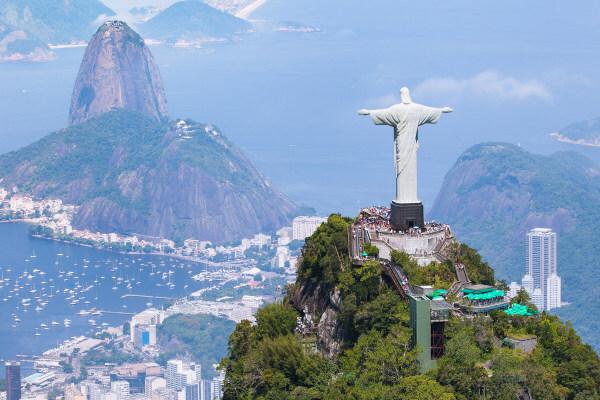O Rio de Janeiro is a Brazilian state located in Southeast region from the country. It is the fourth smallest unit of the federation in area, but the third most populous, bringing together 17.3 million inhabitants. Its capital was also the seat of the Brazilian government, between 1763 and 1960.
The relief of the state is composed of plateaus and plains, and the climate is predominantly Tropical. The beautiful natural landscapes and the rich culture of Rio de Janeiro make the state one of the main tourist destinations in the country.
Read too: What are the capitals of Brazilian states?
General data for Rio de Janeiro
Region: Southeast
capital: Rio de Janeiro
Government: representative democracy
Areatterritorial: 43,750.426 km² (IBGE, 2020)
Population: 17,366,189 inhabitants (IBGE estimate, 2020)
Densitydemographic: 365.23 inhab./km² (IBGE, 2010)
spindle: Brasília Standard Time (GMT -3)
Climate: tropical
Geography of Rio de Janeiro
Rio de Janeiro is a Brazilian state located in the Southeast region, with the city of the same name as its capital. Its territorial area is 43,750 km², the fourth smallest in the national territory, after the Federal District, Sergipe and Alagoas. With
exit to the Atlantic Ocean, the coast of Rio de Janeiro has 636 km, the third longest in Brazil. The state borders with:Holy Spirit, at North
Minas Gerais, to the west
Sao Paulo, South
Rio de Janeiro climate
Predominates in Rio de Janeiro the climate Ttropical, with significant variations between areas closer to the coast, which record higher rates of humidity due to the influence of seafaring, and mountainous regions, whose most important climatic factor is the altitude.
Thus, on the coast of Rio de Janeiro, average temperatures are high and are around 24 ºC. Rainfall rates are the highest in the entire state, ranging from 1250 mm to 1500 mm. Inland, especially in the higher areas, temperatures are relatively milder. It has a dry season, which is the Winter, and rainfall ranges from 1000 mm to 1250 mm per year.
Relief of Rio de Janeiro
The Rio de Janeiro integrates the domain of the East-Southeast Plateaus and Mountains, according to the classification proposed by Jurandyr Ross.
Their distinct features can be compartmentalized into at least three units. The first covers a part of the east of the state (near the coast and the capital) and concentrates its lowest altitudes, which is the Baixada Fluminense. Also on the coastal strip are the so-called coastal massifs. The rest of the state is characterized by theHighland Rio de Janeiro (or highlands), where the mountains, such as the Serra do Mar, hills and escarpments are found.
The state's highest point is the Agulhas Negras peak, located at 2791 meters above sea level.
Vegetation of Rio de Janeiro
The vegetation cover of Rio de Janeiro is composed of characteristic formations of Atlantic forest, biome in which the state is inserted. Thus, rainforests and seasonal semideciduous forests are found. The coast and wetlands are covered by dune vegetation, mangroves and sandbanks.
Rio de Janeiro Hydrography
The Rio de Janeiro it's part of Southeast Atlantic watershed.The Paraíba do Sul is the most important river in the state, crossing the state of Rio de Janeiro from the border with São Paulo. Some of its tributaries are among the main rivers in the state, such as the Pomba and Muriaé rivers. The Grande, Paraibuna, Macaé, Preto and Piraí rivers are also important.
Read too: Hydrographic basins - part of the relief supplied by a main river and its tributaries
Rio de Janeiro map

Demographics of Rio de Janeiro
The current population of the state of Rio de Janeiro is 17,366,189 inhabitants, as indicated by the estimates of the IBGE. It is the third most populous state in Brazil after São Paulo and Minas Gerais. restricted in area, it is densely populated, with 365.23 inhab./km² (IBGE, 2010). It is estimated that this value is, today, of 396.93 inhabitants/km², after a population gain of 1.3 million inhabitants between 2010 and 2020.
The vast majority of people from Rio de Janeiro live in cities, being the 96.7% urbanization rate. The municipality of Rio de Janeiro is the most populous, with 6,747,815 inhabitants. This value is equivalent to 38.8% of the entire population of the state. In addition to the capital, only São Gonçalo has more than 1 million inhabitants. Also noteworthy are the municipalities of Duque de Caxias, Nova Iguaçu and Niterói.
The population of Rio de Janeiro is made up of more women (52%) than men (48%). With regard to age, there are greater numbers of people between 20 and 24 years old and between 30 and 39 years old. Life expectancy at birth in the state is currently 77 years, higher than the national for the same period.
Considering the social indicators, it is highlighted that Rio de Janeiro has HDI of 0.761, the fourth largest in the country.
Geographical division of Rio de Janeiro
The state of Rio de Janeiro is composed of 92 municipalities. These are divided into the so-called immediate geographic regions, a classification adopted by IBGE. At 14 immediate regions people form, therefore, five intermediate regions:
Rio de Janeiro;
Volta Redonda – Barra Mansa;
Petropolis;
Campo dos Goytacazes;
Macaé – Rio das Ostras – Cabo Frio.
Economy of Rio de Janeiro
Rio de Janeiro is the second largest economy in the country, second only to the state of São Paulo. According to IBGE, the Gross Domestic Product (GDP) Rio de Janeiro is R$758.85 billion or 10.8% of Brazil's GDP.
O tertiary sector represents 55.8% of the value added to the state's GDP, as indicated by IBGE. This number excludes public administration and related services. The important role that tourism and services directly and indirectly linked to it play for the sector is highlighted. This activity has been gaining more and more space in the world and national economy, becoming an important source of revenue. The city of Rio de Janeiro is, today, the main destiny Brazilian of visitors foreigners and mainly nationals.

THE extraction of Petroleum and natural gas and, consequently, the petrochemical industry leads their respective sectors in Rio de Janeiro, the state that hosts Petrobras headquarters. The secondary sector is also composed of metallurgy, civil construction, public utility services, maintenance and repair, and the production of food, vehicles and pharmaceuticals.
Farming in the state accounts for less than 0.5% of GDP. Among the crops are sugar cane, coffee, cassava, oranges and bananas. The production of milk and meat (mainly beef and chicken) is also of great importance for the sector.
Read too: What is the difference between import and export?
Government of Rio de Janeiro
The government of Rio de Janeiro is of the representative democratic type. The governors are chosen by the population through elections held every four years. The state executive branch is headed by the governor. The Legislative has, in its composition, three federal senators, 46 federal deputies and 70 state deputies.
Flag of Rio de Janeiro

Infrastructure of Rio de Janeiro
Transport in Rio de Janeiro is mainly via highways. Federal roads link Rio de Janeiro's territory with other areas of Brazil. There are 14 in total, among which are: BR-101, which crosses the entire Brazilian coast from north to south, BR-493 (section known as Rodovia Raphael de Almeida Magalhães), BR-116, BR-040, BR-120 and others.
Through modal rail transport goods from the agricultural and mineral sector towards the exporting ports, also carrying out the transport of passengers. The current extension of its railway network is 1200 km, and is operated by the companies MRS Logística and Ferrovia Centro-Atlântica (FCA). Considering the maritime route, the main ports in Rio de Janeiro are Porto Rio de Janeiro, Porto de Açu and Porto de Itaguaí.
The state has two airports with domestic and international flights and another nine with national and local connections. Thus, Tom Jobim (or Galeão), the largest of them, and Santos Dumont airports, both located in the capital, stand out, as well as the airports of Jacarepaguá and Cabo Frio.
The state also houses the Brazil's only nuclear power generation plant, formed by the Angra I and Angra II plants, in the municipality of Angra dos Reis.

Culture of Rio de Janeiro
The rich cultural composition of Rio de Janeiro is derived from its diverse population, formed by indigenous peoples, Africans, Portuguese and migrants from different parts of the national territory. Many of the elements and cultural manifestations of Rio de Janeiro have international dimension, becoming major attractions of foreign visitors to the state.
Rio's popular festivals reflect its broad cultural mosaic, mixing traditional folkloric and also religious elements from different sources. Between the main celebrations, they are:
O Carnival
the Feast of Yemanja
the Feast of the Divine
the Folia of Kings
O New Year's Eve
Some musical styles are very characteristic of Rio de Janeiro, like the bossa nova, choro, samba, carioca funk and others.
The same diversity is also found in the cuisine, which includes typical dishes such as feijoada, minced meat, knee (stuffed salty), fried sardines, the traditional Globo biscuits and mate tea, the latter two very popular on the beaches people from Rio de Janeiro.
See too: Cultural historical heritage - cultural product of a given society
History of Rio de Janeiro
The first Portuguese expeditions to reach Rio de Janeiro took place at the beginning of the 16th century. the incursion led by Gaspar de Lemos reached the Guanabara Bay, giving name to the area of Rio de Janeiro because they confuse the recôncavo with the mouth of a watercourse. However, there was no establishment in the region, a fact that only happened in 1531. Martim Afonso de Souza was at the head of the first colonizer group to settle in Rio de Janeiro, previously inhabited by indigenous populations.
In 1555, the region was target of French expeditions who sought to exercise control over the area. After five years of disputes, the group was defeated. His expulsion took place only in 1567. In that time span, there wasorigin the city of Rio de Janeiro, founded by Estácio de Sá, in 1565. Two years later, already far from what was seen as a threat by other foreign groups, the village was permanently established on Castelo hill.
Initially sugar, the economy From Rio of Januaryexperienced significant advance from the gold exploration in neighboring Minas Gerais, becoming an important outlet for goods through its ports.
In the year 1763, the city of Rio de Janeiro officially became the capital of Brazil, which was previously established in Salvador (BA). Another key moment was the transfer of the Portuguese royal familyfor the city, in 1808, becoming, shortly thereafter, in 1822, the capital of the Brazilian empire. Since then, mainly the capital has undergone an intense process of urbanization and economic development.
With the Brasilia construction in the Midwest region, Rio de Janeiro is no longer the government headquarters federal government in the year 1960, and the city then became the state of Guanabara. Its incorporation with the current state of Rio de Janeiro took place in 1975.
By Paloma Guitarrara
Geography teacher


